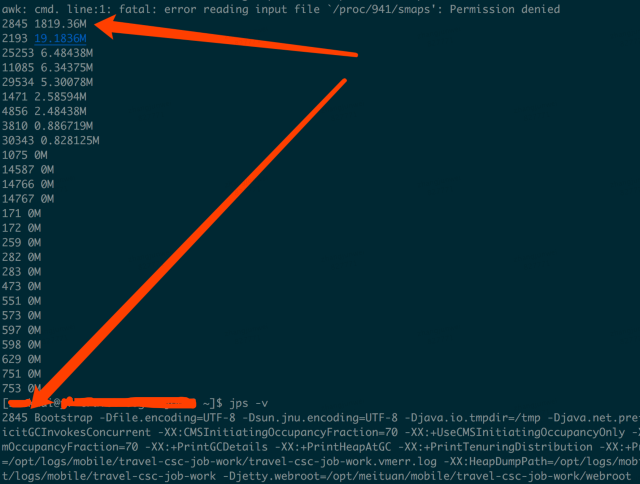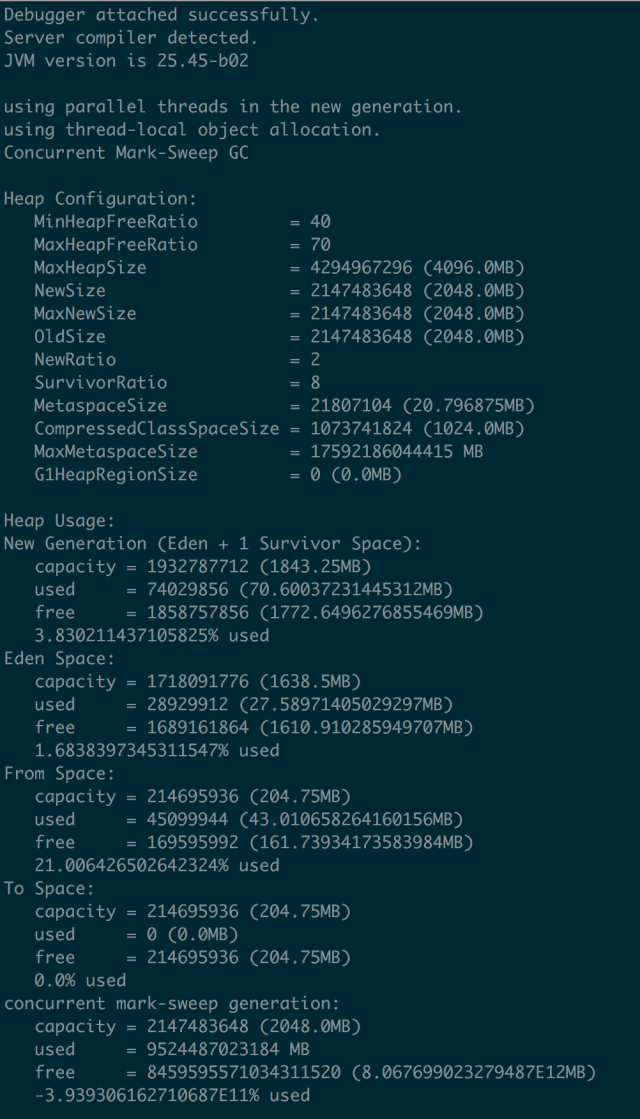【JVM】jdk1.8-jetty-swap被占满问题排查
背景
线上服务收到报警,报警内容:虚拟机swap区占用比例超过80%,如图:

本文着重描述排查问题的过程,在这个过程中不断的猜测–>验证–>推翻–>再猜测–>再验证–>再推翻,这个过程更有意思;
swap是什么
潜意识中,当进程需要申请内存而机器内存不够时,需要将一部分不常用的进程、数据换出到swap,从而腾出一部分物理内存空间;
看下关于Linux swap space的介绍:
Linux divides its physical RAM (random access memory) into chucks of memory called pages. Swapping is the process whereby a page of memory is copied to the preconfigured space on the hard disk, called swap space, to free up that page of memory. The combined sizes of the physical memory and the swap space is the amount of virtual memory available.
Swapping is necessary for two important reasons. First, when the system requires more memory than is physically available, the kernel swaps out less used pages and gives memory to the current application (process) that needs the memory immediately. Second, a significant number of the pages used by an application during its startup phase may only be used for initialization and then never used again. The system can swap out those pages and free the memory for other applications or even for the disk cache.
找出哪些进程占用了swap
如果说swap被占用了,说明物理内存不够,那么需要先找出哪些进程占用了swap,再去看看这些进程是什么原因导致占用swap;
线上虚拟机配置内存为8G,swap为2G,可以通过/proc/$(pid)/smaps找到哪些进程占用了swap;

通过top命令我们也可以看到是java进程占用了1.8G的swap区:

什么原因导致java进程需要申请swap
线上jdk1.8,应用启动参数配置:-Xmx4g -Xms4g -Xmn2g,metaspace用的默认;

通过线上发布记录看到,在11-01号下午发布,11-02号swap开始被占用:

所以第一个怀疑的点便是上线发布导致,此次发布包含两块内容:升级jdk1.7至jdk1.8、分单逻辑优化;首先怀疑的是逻辑优化、导致每分钟java堆内存导致大量对象被创建,但是这些对象的生命周期很短、应该会被快速回收,如果是大量对象创建导致占用内存过多,那么gc次数应该比发布前要频繁,所以再来看gc监控:



发现gc次数频率与之前相比并无明显变化,并且年轻代和年老代内存都在合理范围内;
所以真的是因为分单逻辑优化导致的吗?
Java堆分配了4G、通过jstat看到metaspace用了200M、线程栈大概占用300M(300左右个线程、每个线程1M内存),总共是4.5G左右,而top命令显示java占用的物理内存为6.5G(RES列显示的数据),另外2G是哪里占用了?堆外内存?
所以我们的思路转向到了堆外内存,看看从这个思路上是否可以找出一些线索;
这里通过google-perftools这个工具来查看java进程内存分配情况,其实接下来的排查思路类似这篇文章:JAVA使用堆外内存导致swap飙高
首先安装google-perftools,见这里,java应用启动时加上google-perftools的配置:
export LD_PRELOAD=/home/user/gperftools/lib/libtcmalloc.so
export HEAPPROFILE=/home/user/heap-gperftools/gzip
# 此配置表示进程每分配X字节内存输出一个文件,默认是1G输出一个文件
export HEAP_PROFILE_ALLOCATION_INTERVAL=4073741824
# 此配置表示进程每使用X字节内存输出一个文件,默认是100M输出一个文件,对于我这个应用来说,刚启动生成50多个文件,不便于分析问题,所以我设置的4G左右
export HEAP_PROFILE_INUSE_INTERVAL=4048576000
环境变量配置好重启java应用,此时在目录下就可以看到生成的gzip.0001.heap类的文件,来分析这些文件:
/home/sankuai/gperftools/bin/pprof –text /usr/local/java8/bin/java gzip.0001.heap
对输出的结果进行排序显示前20行:
2060.7 79.1% 79.1% 2060.7 79.1% updatewindow
0.0 0.0% 100.0% 2060.7 79.1% Java_java_util_zip_Inflater_inflateBytes
0.0 0.0% 100.0% 2060.7 79.1% inflate
0.0 0.0% 100.0% 2057.3 79.0% 0x00007f764b47ee05
0.0 0.0% 100.0% 2045.5 78.6% 0x00007f764b6c861f
5.5 0.2% 99.9% 455.3 17.5% Java_java_util_zip_Inflater_init
0.0 0.0% 100.0% 452.7 17.4% 0x00007f764b4f8eb0
449.8 17.3% 96.4% 449.8 17.3% inflateInit2_
0.0 0.0% 100.0% 427.8 16.4% 0x00007f764bb4d16b
45.8 1.8% 98.2% 45.8 1.8% init
0.0 0.0% 100.0% 45.8 1.8% _init@4210
0.0 0.0% 100.0% 45.8 1.8% __do_global_ctors_aux@12b20
0.0 0.0% 100.0% 44.8 1.7% JavaCalls::call_helper
0.0 0.0% 100.0% 43.9 1.7% start_thread
0.0 0.0% 100.0% 42.8 1.6% 0x00007f764b32e4e6
0.0 0.0% 100.0% 41.9 1.6% JavaMain
8.3 1.5% 99.6% 38.3 1.5% os::malloc
0.0 0.0% 100.0% 35.5 1.4% 0x00007f764b33598c
0.0 0.0% 100.0% 28.3 1.1% 0x00007f764b33570f
0.0 0.0% 100.0% 26.3 1.0% jni_invoke_static
可以看出Java_java_util_zip_Inflater_inflateBytes方法分配了比较多的内存,再分析其它heap文件,也都是这个方法,所以从这个方法入手继续追踪,需要找到是业务哪行代码调用了Inflater类,这里我们使用btrace这个工具,btace脚本如下;
import static com.sun.btrace.BTraceUtils.*;
import com.sun.btrace.annotations.*;
import java.nio.ByteBuffer;
import java.lang.Thread;
@BTrace
public class BtracerInflater{
@OnMethod(
clazz="java.util.zip.Inflater",
//method="inflateBytes"
method="inflate"
)
public static void traceCacheBlock(){
println("Who call java.util.zip.Inflater's methods :");
jstack();
}
}
通过打印inflate方法的调用堆栈,找到两处调用:一处是公司的监控组件、一处是jetty启动时扫描jar包会用;
先分析公司的监控组件,监控组件会每隔1分钟去服务器拉取监控配置信息(比如路由IP地址、客户端连接超时时间、长SQL阈值配置等),而服务器返回的配置信息是xml格式,在解析xml时会用到inflate方法,于是我们通过禁用监控组件、重启应用、发现java应用所占的物理内容并没有减少,所以排除是监控组件的问题;
再来看btrace打印的jetty调用栈:
Who call java.util.zip.Inflater's methods :
java.util.zip.Inflater.inflate(Inflater.java)
java.util.zip.InflaterInputStream.read(InflaterInputStream.java:152)
java.io.FilterInputStream.read(FilterInputStream.java:133)
java.io.FilterInputStream.read(FilterInputStream.java:133)
org.objectweb.asm.ClassReader.a(Unknown Source)
org.objectweb.asm.ClassReader.<init>(Unknown Source)
org.eclipse.jetty.annotations.AnnotationParser.scanClass(AnnotationParser.java:888)
org.eclipse.jetty.annotations.AnnotationParser$2.processEntry(AnnotationParser.java:847)
org.eclipse.jetty.webapp.JarScanner.matched(JarScanner.java:161)
org.eclipse.jetty.util.PatternMatcher.matchPatterns(PatternMatcher.java:100)
org.eclipse.jetty.util.PatternMatcher.match(PatternMatcher.java:82)
org.eclipse.jetty.webapp.JarScanner.scan(JarScanner.java:84)
org.eclipse.jetty.annotations.AnnotationParser.parse(AnnotationParser.java:859)
org.eclipse.jetty.annotations.AnnotationParser.parse(AnnotationParser.java:874)
com.xxx.boot.RJRAnnotationConfiguration.parseWebInfClasses(RJRAnnotationConfiguration.java:96)
org.eclipse.jetty.annotations.AnnotationConfiguration.configure(AnnotationConfiguration.java:113)
org.eclipse.jetty.webapp.WebAppContext.configure(WebAppContext.java:468)
org.eclipse.jetty.webapp.WebAppContext.startContext(WebAppContext.java:1247)
org.eclipse.jetty.server.handler.ContextHandler.doStart(ContextHandler.java:710)
org.eclipse.jetty.webapp.WebAppContext.doStart(WebAppContext.java:494)
org.eclipse.jetty.util.component.AbstractLifeCycle.start(AbstractLifeCycle.java:64)
org.eclipse.jetty.server.handler.HandlerCollection.doStart(HandlerCollection.java:229)
org.eclipse.jetty.util.component.AbstractLifeCycle.start(AbstractLifeCycle.java:64)
org.eclipse.jetty.server.handler.HandlerWrapper.doStart(HandlerWrapper.java:95)
org.eclipse.jetty.server.Server.doStart(Server.java:280)
org.eclipse.jetty.util.component.AbstractLifeCycle.start(AbstractLifeCycle.java:64)
sun.reflect.NativeMethodAccessorImpl.invoke0(Native Method)
sun.reflect.NativeMethodAccessorImpl.invoke(NativeMethodAccessorImpl.java:62)
sun.reflect.DelegatingMethodAccessorImpl.invoke(DelegatingMethodAccessorImpl.java:43)
java.lang.reflect.Method.invoke(Method.java:497)
com.xxx.Bootstrap.main(Bootstrap.java:101)
jetty的调用场景是:为了支持Servlet规范中的注解方式(使得不再需要在web.xml文件中进行Servlet的部署描述,简化开发流程),jetty在启动时会扫描class、lib包,将使用注解方式声明的Servlet、Listener注册到jetty容器,在扫描jar包的时候调用了inflate,分配了大量的内存,此时通过关键词搜索到Memory leak while scanning annotations,这篇文章给出了两种解决方法,一种是评论处所说,禁用缓存(说是jdk1.8的bug):
Here’s a link to the java bugs database issue: http://bugs.java.com/bugdatabase/view_bug.do?bug_id=8156014
I’d like to be able to comment on it, but I can’t seem to find a link to allow me to do that.
The comments I’d like to add are:
the problem is still reproduceable as of jdk8u112
the problem seems to be fixed in jdk9: I tested jdk9ea+149 and couldn’t reproduce
I’ve tried some workarounds for jdk8: it seems the ServiceLoader impl uses the jarurlconnection caching, so it may be of some benefit to try to disable url caching (although not sure of the effects on performance).
Try creating an xml file (eg called “caches.xml”) with the following contents:
<Configure id="Server" class="org.eclipse.jetty.server.Server">
<Set class="org.eclipse.jetty.util.resource.Resource" name="defaultUseCaches">false</Set>
<New class="java.io.File">
<Arg>
<SystemProperty name="java.io.tmpdir"/>
</Arg>
<Call name="toURI">
<Call id="url" name="toURL">
<Call name="openConnection">
<Set name="defaultUseCaches">false</Set>
</Call>
</Call>
</Call>
</New>
</Configure>
尝试之后,java进程占用的物理内存由6.5G降到了5.9G,有一定的效果,但是我们估算的java进程应该占4.5G左右,还有1.4G内存被谁占用了呢?
再尝试另外一种方法:
We were investigating a Jetty application that used much more memory than it was supposed to do (near a Gb more than the max heap size plus the max metaspace size). We found out that the extra memory was Native memory, being allocated using malloc via some library (we don’t have native code in our app). Then we used jemalloc ( http://www.canonware.com/jemalloc/) to find out which class was doing this allocation and we found out that it was java.util.zip.Inflater. Via jstack we were able to find calls to the library and the main caller was Jetty, while in the process of looking for annotations. We disable annotations for the application and the memory usage went back to normal.
既然jetty调用是因为扫描jar包中的注解,我们应用中没有通过注解声明的Servlet、Listener,是不是可以不需要扫描这一步,故而在jetty.xml中将注解扫描的方式去掉:
<!-- <Item>org.eclipse.jetty.annotations.AnnotationConfiguration</Item> -->
<!-- Item>com.xxx.boot.RJRAnnotationConfiguration</Item> -->
再重启应用,发现内存使用由6.5G降到了3.9G,并且应用运行稳定后不再占用swap,如图:

看下对比:
| 机器 | 改动 | 内存使用 | 系统稳定运行后 |
|---|---|---|---|
| 机器1 | 什么都不变 | java占用物理内存6.5G |  |
| 机器2 | 禁用jetty resource缓存 | 从6.5G降到5.9G |  |
| 机器3 | 禁用注解扫描 | 从6.5G降到3.9G |  |
总结
总结下排查问题的大概思路:
- 确认哪些进程占用了swap;(定位到是java进程)
- 理论上java进程不应用占用6.5G物理内存,通过gperftools工具查看java进程内存分配;(排除堆内内存问题,找到java.util.zip.Inflater类分配内存较多)
- 通过btrace定位哪些地方调用了java.util.zip.Inflater类;(排除监控组件的问题、锁定jetty启动调用)
- 尝试不同解决方法;
- 最后物理内存是降了,但是这就是最优解吗?这种方法是不是一种逃避解决方案(相当于不能使用Servlet注解方式)?
- 有没有更好的解决方法?
- 如果说是jdk1.8的问题,那么其它地方用jarurlconnection cache的地方是不是都存在内存泄漏?1.7的实现和1.9的实现是什么样的?
- 其它Servlet容器会不会存在这种问题?Tomcat也实现了Servlet规范,是如何实现的?
出处:
http://www.longtask.net/2018/11/15/swap-used-full/#top
【JVM】jdk1.8-jetty-swap被占满问题排查的更多相关文章
- 一次 KVM 虚拟机磁盘占满的排查过程
一次 KVM 虚拟机磁盘占满的排查过程 KVM 虚拟机系统为 CentOS,文件系统为 XFS. 现象如下: 使用 df -h 命令发现磁盘剩余空间为30k(总大小为30G),使用 df -i 发现 ...
- 【JVM】内存和SWAP问题
一.现象 1.系统稳定运行,偶尔发生响应超时的情况.查看下游依赖服务和数据库状态都良好.超时完全是由于服务本身问题造成的.重启不能解决问题,一直会间隔性的发生超时 二.原因分析 第一种情况,系统内存够 ...
- JVM CPU占满问题定位
RASP加载后出现JVM CPU占满问题,jstack -F输出信息无法找到对应占用CPU的线程 perf定位到占用CPU的热代码位于Dependencies::find_finalizable_su ...
- linux磁盘空间占满问题快速定位并解决
经常会遇到这样的场景:测试环境磁盘跑满了,导致系统不能正常运行!此时就需要查看是哪个目录或者文件占用了空间.常使用如下几个命令进行排查:df, lsof,du. 通常的解决步骤如下:1. df -h ...
- 网页或微信小程序中使元素占满整个屏幕高度
在项目中经常要用到一个容器元素占满屏幕高度和宽度,然后再在这个容器元素里放置其他元素. 宽度很简单就是width:100% 但是高度呢,我们知道的是height:100%必须是在父元素的高度给定了的情 ...
- Unity打开摄像头占满全屏
Unity打开摄像头占满全屏 AR项目需求,Unity打开摄像头作为背景渲染占满全屏~ Unity对设备硬件操作的API并不是太友好~打开一个摄像头,渲染到屏幕上也都得自己写,虽然步骤少,提取摄像头t ...
- windows系统c盘占满/linux系统磁盘block、inode占满处理
windows系统 下载c盘清理.bat到服务器,双击bat文件将自动清理 linux系统 先远程ssh登录上服务器,登录教程:http://www.west263.com/faq/list.asp? ...
- js控制 固定框架内图片 按比例显示 以及 占满框架 居中显示
js控制 固定框架内图片 等比例显示 以及 占满框架 纵横居中显示 通过设置 js函数 fitDiv里面var fit的值就好 function fitDiv (obj) { var target_w ...
- bash: /usr/lib/jvm/jdk1.7.0_80/bin/java: No such file or directory 问题
在安装java的时候,经常会遇到一些奇奇怪怪的问题. 在配置好环境变量之后,执行java -version,出现: bash: /usr/lib/jvm/jdk1.7.0_80/bin/java: N ...
随机推荐
- JAVA字符编码一:Unicode,GBK,GB2312,UTF-8概念基础
第一篇:JAVA字符编码系列一:Unicode,GBK,GB2312,UTF-8概念基础 来源:holen'blog 对字符编码与Unicode,ISO 10646,UCS,UTF8,UTF16, ...
- 主题模型TopicModel:主题模型LDA的应用
http://blog.csdn.net/pipisorry/article/details/45665779 主题模型LDA的应用 拿到这些topic后继续后面的这些应用怎么做呢:除了推断出这些主题 ...
- Refused to execute script from '...' because its MIME type ('') is not executable, and strict MIME type checking is enabled.
写在前面 部署项目到weblogic上启动首页访问空白, 浏览器控制台报如题错误. web.xml中把响应头添加防止攻击的报文过滤器禁用就行了(仅仅是为了启动), 以下为转载内容, 可以根据需要自行测 ...
- JVM探究之 —— 类文件结构(脑图)
- 使用Faker来随机生成接近真实数据的数据
在很多场景我们需要造一些假数据或者mock数据,如果我们写死类似[XXXX]类似的无意义的其实不是很优雅,Faker能提供常用的一些名词的随机数据. 1.引入POM: <dependency&g ...
- Spring不能直接@autowired注入Static变量/ 关于SpringBoot的@Autowired 静态变量注入
昨天在编写JavaMail工具类的时候,静态方法调用静态变量,这是很正常的操作,当时也没多想,直接静态注入. @Component public class JavaMailUtil { @Autow ...
- 文档工具的王者Sphinx
Sphinx https://www.sphinx.org.cn/ Sphinx是一个工具,可以轻松创建由Georg Brandl编写并根据BSD许可证授权的智能和美观文档 它最初是为Python文档 ...
- 路径规划: PRM 路径规划算法 (Probabilistic Roadmaps 随机路标图)
随机路标图-Probabilistic Roadmaps (路径规划算法) 路径规划作为机器人完成各种任务的基础,一直是研究的热点.研究人员提出了许多规划方法如: 1. A* 2. Djstar 3. ...
- (记录问题)1.Canvas.drawArc()方法的问题
先看看异常: 一眼看去就知道说的是方法找不到错误 后面发现是系统版本过低,4.0的系统找不到5.0后添加的方法报的错. 修改后完美解决
- elastalert 用import属性来组织,引入配置
对应rule的一些公用规则,可以放到一个或者多个头文件中.主的rule yaml文件引入即可.文件名随意,最好别用yaml后缀,要不会被当做一个rule.另外import在rule文件中只能出现一次. ...
